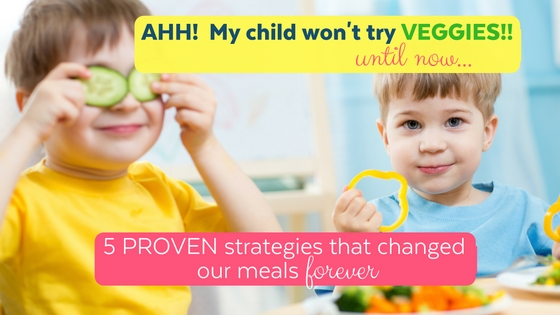Why won’t my kid eat veggies??? [you ask as you tug the hair on your head]. So frustrating right!
Our little ones are willing to try a new cookie or cupcake. No problem there.
But try a new veggie (or any veggie in some cases)? Heck no!
So what’s up with the veggie haters?
A few factors come into play here:
(1) Kids know how badly we want them to eat those vegetables and will do the opposite of what parents want (through to the hormonal teenage years, I’ve been told). Our little ones can see and sense our desperation to get some carrots, cauliflower or other veggies into their repertoire of foods. If there’s even a subtle pressure to eat them and they will turn away.
(2) High carbohydrate and less nutrient-dense foods simply taste better. They also offer more energy with fewer bites. I talk more about kid’s love for carbs here.
(3) Vegetables can be difficult to eat. They are fibrous and require more effort to chew, hence kids will opt for foods that require less work and time at the table (so they can get back to playing).
(4) Genetics. Some children are classified as “super tasters” meaning they have a gene that makes the bitterness in veggies more pronounced. “Part of the pickiness can be attributed to specific genes that govern taste. Variants of the TAS2R38 gene, for example, have been found to encode for taste receptors that determine how strongly someone tastes bitter flavours.” (Source)
Whether your little one is carb-crazy or a “super taster”, it does not mean they will forever be veggie-haters.
Being “picky” today doesn’t always mean they’ll be “picky” tomorrow
Research shows that 1 in 4 children continue to be picky eaters as adults. The determining factors are the mealtime environment, the parent’s approach, along with how often foods are presented. These factors will dictate whether our kids continue to be picky as adults or not.
It’s just a matter of doing the right thing at meals (most of which is common sense but parents may need a little help).
If we follow the common advice given and sneak veggies into sauces, mash them into muffins, or blend them into smoothies….we will likely be successful in the short term. If kids don’t know what they are eating, chances are they will eat it.
However…
I don’t want to GET my kids to eat veggies…or anything for that matter.
I want them to LEARN to like veggies – what they are, what they look and taste like – in the short AND long term. Even at the risk of those greens not being a favourite food (for now). Learning about food can’t happen without seeing a food and knowing it is there.
So I take a different approach when it comes to feeding my kids veggies. Thankfully the research (and my veggie-
loving daughters) suggest I’m doing something right!
5 Ways to Help Kids Eat Learn to Like Veggies
1. Be neutral about veggies.
The more we make it known that we REALLY WANT THEM TO EAT THEIR VEGGIES, the more our little ones withdraw. If we say “You have to eat your cucumber if you want your ice cream” they hear ice cream must be really good and cucumbers must not be that good (if I have to eat them).
Try This: Casually explain which foods are being offered for dinner, etc. Then eat your veggies (SO important) and say nothing else.
2. Make veggies taste good too.
Remove the health and guilt factor for a moment and answer this: Would you rather eat some cauliflower or a cookie? I’m a Nutritionist and will admit (albeit reluctantly) that a cookie would be my choice. Cauliflower is good too…buuut a cookie simply tastes better (even the ridiculously healthy versions like my Pumpkin Cookies or my ABC Cookies). Well, what if we made veggies taste delicious too? What if we used some spices? Do not fear thou spice! Remember our little ones had exposure to flavour in their earliest days, so why stop now? “In the womb, the growing baby gulps down several ounces of amniotic fluid daily. That fluid surrounding the baby is actually flavored by the foods and beverages the mother has eaten in the last few hours.” (S
Try This: Find a flavour or texture that your child already enjoys (citrusy, salty, sweet, soft, chewy, breaded, crunchy, etc). and use that for some veggie inspiration. If they gravitate to something like creamy like Mac & Cheese, try one with Cauliflower Alfredo Sauce like this (but don’t sneak it in). Or take it a step further and try this incredible Dairy-Free Broccoli Cauliflower Casserole!
3. Help them be successful.
For some of our little ones, trying a new food or veggie is no big deal. For other kids, like my daughter a few years ago, working themselves up to eat a carrot stick can be really tough. It may be driven by genetics (i.e. super tasters), personalities, sensory challenges, or oral motor delays. Or simply, kids being kids. Whatever the reason, the best thing we can do as parents is create an environment that makes eating fun…and easy. We want an environment where our kids can feel like they are successful at the table. Even if they aren’t “eating” per se.
Try This: Create opportunities for our little ones to explore new foods by working them up this hierarchy. Try the Curious Cookie Mat! These revolutionary placemats make trying new foods fun. Your child can explore the sensory properties of food in a non-pressure way. Get yours at www.curiouscookiekids.com

4. Give it a name.
What we say at dinner is just as important as what we do/make for dinner (or lunch, etc). Studies show that giving veggies more attractive names like “X-Ray vision carrots,” “Silly Dilly Green Beans” and “Power Punch Broccoli” increases veggie intake. Schools that offered veggies with fun names saw vegetable purchases increase 99%. On the other hand, they declined by 16% in schools that did not.
Try This: Consider your child’s interests. Is it dinosaurs? Then create a plate with Broccoli Bushes, Tiny Asparagus Tree Tops, Rice Mountains, Blueberry River and send the hungry dino snacking.
5. Let them play with their peas.
It makes sense that we would discourage our kids from getting messy and playing with food, but that’s how they learn what food is. I always remind the moms I work with and Picky Eater Protocol members that success at mealtimes is not whether they eat the vegetables. It’s whether they are comfortable with said food and seeing our kids interact with it. The more willing they are to touch, smell, and squish food, the better the chances that they will eat it.
Try This: At the end of your next meal, if there are any uneaten veggies (or other foods) take a few minutes to play with it. If it’s green peas, pretend they are a soccer ball and your fingers are the kickers. Play a little game with your little guy or gal. If it’s roasted carrot coins try to balance it on your nose or tongue and see who can hold it the longest.
Ultimately, the more they interact with new veggies the more likely they are to try it and like it.







how to introduce any food to a 1 year and 9 months old kid who has repulsion of food…who refuses to take any new food ???